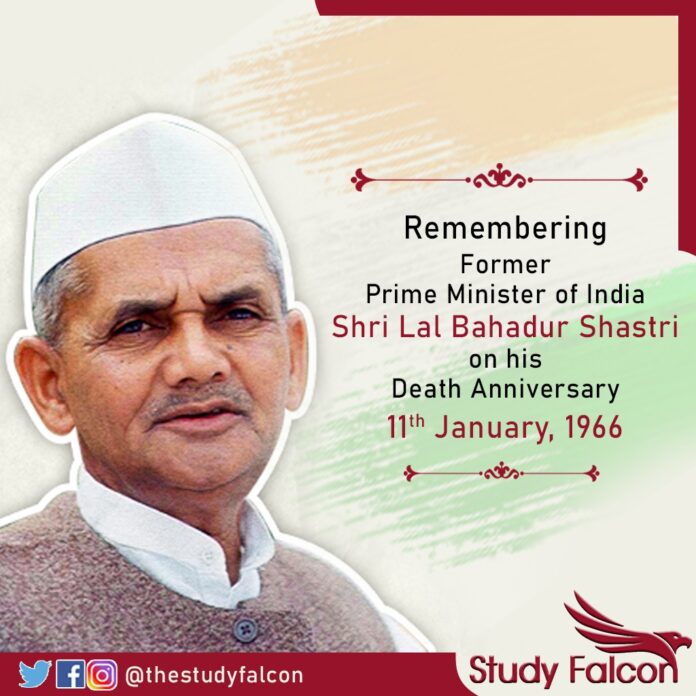January 11 marks the death anniversary of Lal Bahadur Shastri — an Indian politician who served as the country’s second Prime Minister. He held key portfolios in Jawaharlal Nehru-led Central government in the first 17 years of Independent India and is credited for prompting both White Revolution and Green Revolution in the country. His slogan of ‘Jai Jawan Jai Kisan’ which means ‘Hail the soldier, Hail the farmer’, became a clarion call and is still remembered.
Shastri was born to Sharada Prasad Srivastava and Ramdulari Devi in Mughalsarai on 2 October in the year of 1904, sharing his birthday with Mahatma Gandhi. He studied in East Central Railway Inter college and Harish Chandra High School, which he left to join the non-cooperation movement. He worked for the betterment of the Harijans at Muzaffarpur and dropped his caste-derived surname of “Srivastava”. Shastri’s thoughts were influenced by reading about Swami Vivekananda, Gandhi and Annie Besant. Deeply impressed and influenced by Gandhi, he joined the Indian independence movement in the 1920s. He served as the president of Servants of the People Society (Lok Sevak Mandal), founded by Lala Lajpat Rai and held prominent positions in Indian National Congress.
Following India’s independence, Shastri was appointed as the Parliamentary Secretary in his home state, Uttar Pradesh. He became the Minister of Police and Transport under Govind Ballabh Pant’s Chief Ministership on 15 August in 1947 following Rafi Ahmed Kidwai’s departure to become a minister at the centre. As the Transport Minister, he was the first to appoint women conductors. As the minister in charge of the Police Department, he ordered that police use water jets, whose instructions was given by him, instead of lathis to disperse unruly crowds. His tenure as police minister (as Home Minister was called prior to 1950) saw successful curbing of communal riots in 1947, mass migration and resettlement of refugees. He gained a reputation as a skillful mediator after his appointment to the influential post of minister for home affairs in 1961. Three years later, on Jawaharlal Nehru’s illness, Shastri was appointed minister without portfolio, and after Nehru’s death he became prime minister in June 1964.
Shastri was criticized for failing to deal effectively with India’s economic problems, but he won great popularity for his firmness on the outbreak of hostilities with neighbouring Pakistan (1965) over the disputed Kashmir region. He died of a heart attack after signing a “no-war” agreement with Pres. Ayub Khan of Pakistan and was succeeded as Prime Minister by Indira Gandhi, Nehru’s daughter.
To honour Lal Bahadur Shastri, the Lal Bahadur Shastri Memorial, in New Delhi, was inaugurated by former Prime Minister Dr. Manmohan Singh on May 7, 2005. All the items related to Shastri’s life in this memorial show Shastri’s hard work, honesty, and simplicity. Lal Bahadur Shastri Memorial was the residence of Lal Bahadur Shastri. In fact, this bungalow is a symbol of Shastriji’s simplicity and humility. Lal Bahadur Shastri, honored with Bharat Ratna’s title, resided in this Lutyens Bungalow from 1952 to 1966. This bungalow was allotted to Lal Bahadur Shastri when he was a Union Minister. Due to his simplicity, he kept his own house even after becoming Prime Minister and did not go to the big bungalow.
More than thirty years of dedicated service were behind Lal Bahadur Shastri. In the course of this period, he came to be known as a man of great integrity and competence. Humble, tolerant, with great inner strength and resoluteness, he was a man of the people who understood their language. He was also a man of vision who led the country towards progress. Lal Bahadur Shastri was deeply influenced by the political teachings of Mahatma Gandhi. “Hard work is equal to prayer,” he once said, in accents profoundly reminiscent of his Master. In the direct tradition of Mahatma Gandhi, Lal Bahadur Shastri represented the best in Indian culture.










